Why they call this place ‘Alice Springs by the beach’
By Helen Pitt
Broome from above is a sight to behold: the aquamarine of the Indian Ocean, the white sand, red rocks and ochre colour of the desert, and the rich greens of the mangroves. It’s a vivid colour palette that helps you understand why John Olsen painted the Australian landscape the way he did. And why they call this place Alice Springs by the beach. I am mesmerised from the moment I spy it out my plane window.
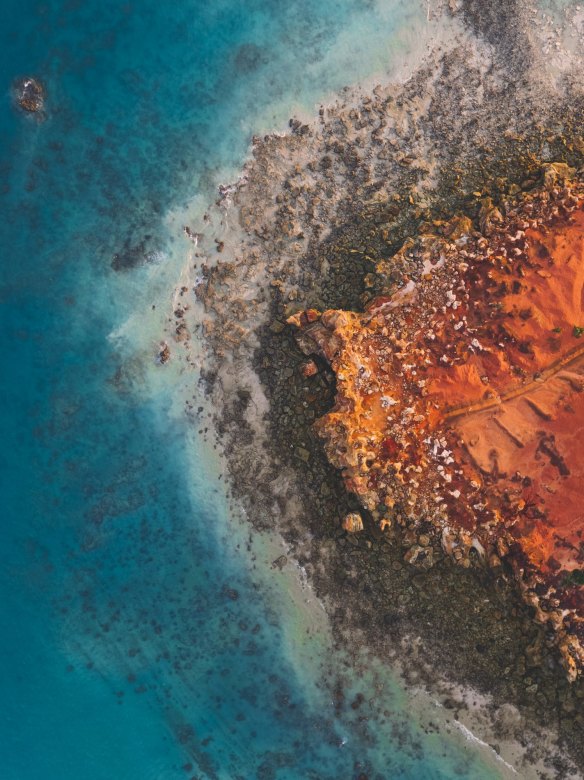
Gantheaume Point near Broome.Credit: Tourism WA
My London-bound son and I are escaping a wet, windy and cold east coast for Western Australia. We nearly didn’t make our early morning flight out of Sydney. The alarm didn’t go off. The Uber didn’t show, and the taxi was slow to arrive. We were fast-tracked aboard with what seemed like seconds to spare, which made landing in Broome’s blue skies and 31 degree sunshine, all the more delightful.
As we pick up our hire car, there’s no traffic in sight, and my gut tells me I am right to have always wanted to come here. Those wide open skies and roads beckon.
We head to the Mangrove Hotel, shed our winter layers for swimmers and jump straight in to its palm-fringed pool. Refreshed, I don a frock, pick a hibiscus for my hair and head straight for the pearl meat cook-off at the annual Shinzu Matsuri Festival (festival of the pearl.)
First a confession: while I am accustomed and partial to eating Sydney rock oysters, I have never tasted the delicacy that is pearl meat, the ear-shaped adductor muscle of the South Sea oyster. That’s about to change when almost every hotel and travel outfit in the Broome region descends on Pearl Luggers in Broome’s Chinatown to plate it up for us.
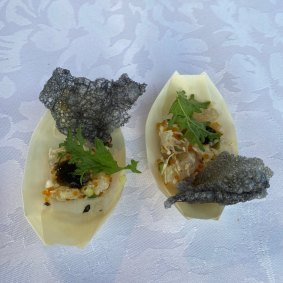
Pearl meat served at the Broome cook-off.Credit: Helen Pitt
It is a sort of outdoor museum. There, among the old displays of the first hard-hats used by divers more than 140 years ago when they first walked the coralline sea beds, chefs serve up the delicacy in a variety of ways: from barbecued with a mango and coconut puree through to marinated in lemon juice, coriander and grilled served with a garnish of ginger and radish. It has a tender texture best appreciated raw, cured or lightly seared. It’s cubed, diced and devoured a dozen different ways. Every mouthful of pearl meat is delicious.
You’ll hear from the moment you arrive here that Broome was built on buttons; mother-of-pearl ones. In the mid-1800s, the discovery of rich pearl shell beds off 80 Mile Beach sparked a Gold Rush–style influx of settlers from Japan, China, Malaysia, East Timor and the Philippines to work in the then perilous pearl industry.
For almost a century, the Pinctada maxima pearl shells farmed here were exported for use in the fashion industry. When the advent of plastic dimmed their appeal, the commercial focus shifted to cultivating pearls for jewellery, a string of which locals will tell you should reflect the wearer’s whites of their eyes and the pearly whites of their teeth. Now the lucrative pearl meat industry is breathing life into the local economy, with its evolution into a foodstuff as rare as truffles and caviar, and as equally expensive.
You can eat oysters here, at the Sydney Cove Oyster Bar which once was on the harbour right near the Opera House, but moved to Broome during COVID. But we save that and the obligatory sunset on Cable Beach camel ride for another night.
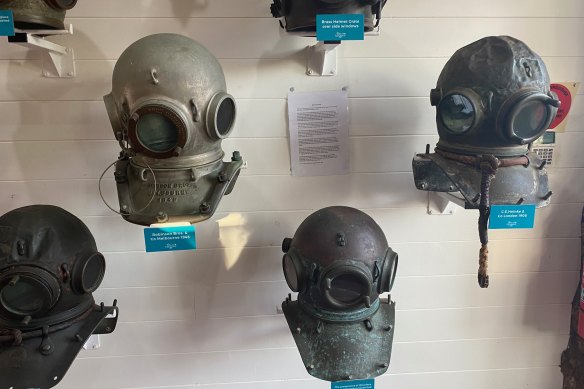
Display of the first hard-hats used by divers at Pearl Luggers.Credit: Helen Pitt
On our first night, still only a few hours since we’d left the big east coast smoke, we watch the moon rise over the night market at Town Beach. We spot our first boab tree, its swollen base lit by light and looking lovely, then fall into bed exhausted.
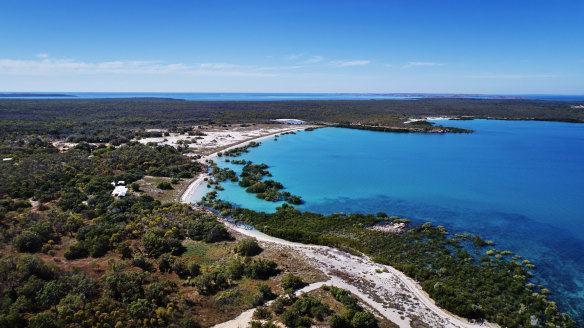
Cygnet Bay.Credit: Tourism WA
The next morning we are up in time for sunrise, which is always the breeziest time of day. As the rays peek up over Roebuck Bay, it is hard not to fall in love with this old pearling town, that was the setting for Bran Neu Day, the first Aboriginal Australian musical.
After a quick breakfast we hit the long straight road - 250 kilometres of it up the Dampier Peninsula to Cygnet Bay Pearl Farm.
The Cape Leveque Road is now a sealed all-weather road, and it’s a dreamy outback drive, which does not require a 4WD, but is highly recommended, especially if you want to detour.
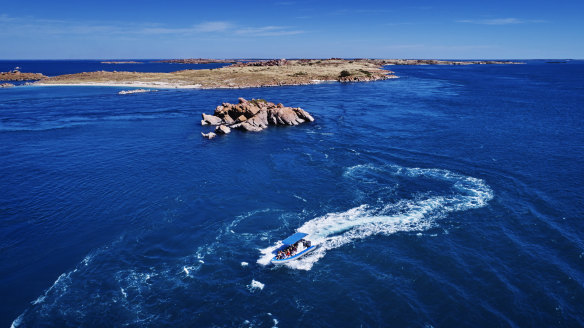
The giant tides just out of Cygnet Bay.Credit: Tourism WA
En route we take a call from Bardi Jawi woman Rosanna Angus, who runs Oolin Sunday Island Cultural tours. She explains the time of our Indigenous cultural tour by boat has changed.
“In the Kimberley the tides are the boss,” Angus explains.
The Kimberley coast has some of the highest tides in Australia, up to 14 metres, and she wants to take us to her ancestral home, Ewuny, once a pearling station then a mission from 1899. But we are at the mercy of the tides.
There’s no time to lounge about on arrival at our Pearler’s Village glamping tent or drop into the pearl museum; we drop our bags and head straight for her boat.
The Bardi and Jawi are the traditional owners from the tip of the Dampier Peninsula and the islands at the entrance of King Sound.
On the way to Oolin we pass through the whirlpools and eddies between Jooloom and Jayirri and feel the power of the giant tides; some of the world’s strongest.
On arrival at the island, a shark circles us in the clear water. We jump ashore and head up a steep hill for an astounding view of the former settlement, with its old banana and mango trees planted to sustain the community.
Angus picks up an old marble and gazes at in wonder as if it is an object more precious than the cultured pearls Cygnet Bay farms and is famed for. One of her ancestors no doubt played with this as a child in the school playground, she muses as it catches the light.
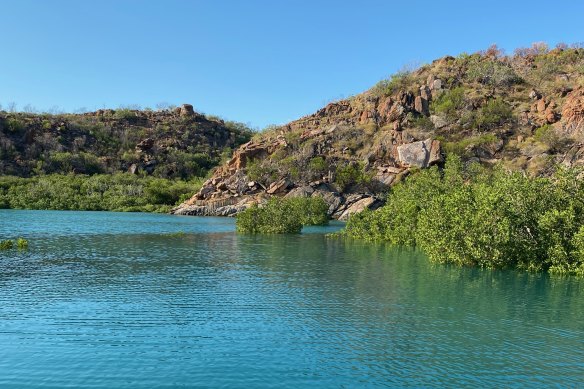
Secluded cove on Oolin, formerly Sunday Island.Credit: Helen Pitt
“Every time I come here I find something precious,” she tells us.
The Sunday Island Catholic mission was formally closed in 1965, and in 1972 the island dwellers - mainly five or six clans - formed a community at One Arm Point, where Angus still lives with around 300 others. Mass is still celebrated every Sunday.
“Times were moving on and people were wanting to earn money which was impossible to do here ... It was pretty hard to transport food and if you needed a hospital it was a long way to one,” she tells us.
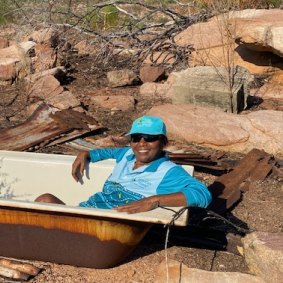
Tour leader Rosanna Angus finds an old bath tub on her ancestral island, Oolin.Credit: Helen Pitt
We visit the barge landing, where supplies and people were ferried to and from the island and understand what she means. She then takes the boat to a secluded (no-croc) cove, where we swim while she boils the billy and passes around the still-warm damper she’d just baked and serves it with butter and lashings of Golden Syrup. A pair of jaburi birds stare down at us from up high on the cliffs, then fly down towards us as we leave.
On the way back to Cygnet Bay or Borrgoron as it is known locally, a whale breaches just before the sun sets. My son Liam turns to Angus and smiles as he tells her:“London is going to be hard to top our first 24 hours in Broome.”
THE DETAILS
TOURS
Oolin Sunday Island Cultural Tours: Usually daily but tide dependent. Ranging from $250-$350.
Cygnet Bay Peal Farm: Glamping safari tents, camping and caravan sites available.
Pearl farm discovery tour (one hour) pearl grading and carving classes (all cost $37) offered daily.
FESTIVALS
The 2023 Shinzu matsuri festival (festival of the pearl)runs from August 26 - Sunday September 10.
FLY
Virgin and Qantas fly daily to Broome from Sydney and Melbourne; check days for direct flights or go via Perth.
Helen Pitt travelled as a guest of Tourism WA and Ponant Cruises. au.ponant.com
Sign up for the Traveller Deals newsletter
Get exclusive travel deals delivered straight to your inbox. Sign up now.